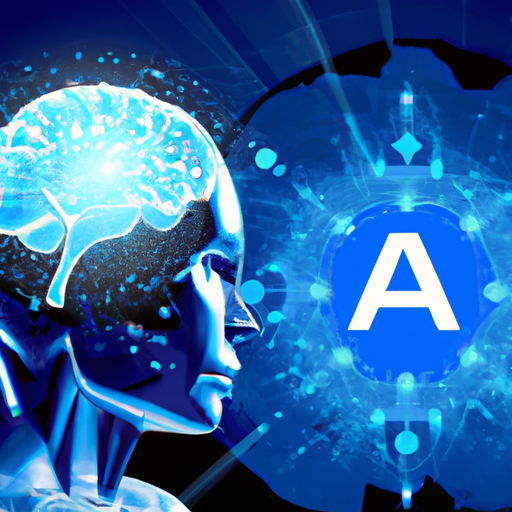
In this article, we’ll explore what AI stands for and its significance in today’s world. You will learn about the concept of artificial intelligence and how it has revolutionized various industries. We’ll also discuss how AI is impacting our daily lives, from virtual assistants to automated vehicles. By the end, you’ll have a clear understanding of what AI stands for and why it is such a hot topic in modern technology.

Definition of AI
Artificial Intelligence (AI) refers to the simulation of human intelligence in machines that are programmed to think and learn like humans. It involves the development of intelligent computer systems that can perform tasks without being explicitly programmed for each step. These systems are designed to perceive their environment, reason about it, and make decisions based on the available information. AI aims to create machines that can perform tasks that typically require human intelligence, such as understanding natural language, recognizing patterns, and making decisions.
Understanding the concept of artificial intelligence
The concept of AI is rooted in the goal of creating machines that can think and act like humans. AI systems are programmed to analyze vast amounts of data, learn from it, and generalize the acquired knowledge to perform a wide range of tasks. The objective is to develop intelligent machines capable of solving complex problems, providing insights, and automating processes that were previously done by humans.
Different perspectives on defining AI
Defining AI can be complex, as it encompasses various aspects and approaches. From a technical perspective, AI is often classified into two categories: narrow AI and general AI. Narrow AI, also known as weak AI, refers to systems designed for specific tasks and lacks the ability to perform tasks beyond their programming. On the other hand, general AI, also known as strong or human-level AI, refers to systems that possess the ability to understand, learn, and apply their intelligence to a wide range of tasks, similar to human capabilities.
Key characteristics of AI
Artificial intelligence systems possess several key characteristics that enable them to perform intelligently:
-
Adaptability: AI systems can learn from past experiences and adapt their behavior accordingly. They have the ability to improve their performance over time through continuous learning and feedback.
-
Autonomy: AI systems can make decisions and perform tasks without continuous human intervention. They can evaluate options, choose the most appropriate action, and execute it based on their programming and acquired knowledge.
-
Perception: AI systems can perceive and understand their environment using various sensors and input devices. They can gather information from their surroundings, interpret it, and respond accordingly.
-
Reasoning and Decision Making: AI systems can analyze complex information, identify patterns, and make decisions based on the available data. They can evaluate different options and select the most optimal course of action.
-
Natural Language Processing: AI systems can understand and communicate in natural human language. They can interpret and generate human-like text, speech, and other forms of communication.
-
Problem Solving: AI systems excel at solving complex problems by breaking them down into smaller sub-problems, analyzing them, and deriving solutions. They can employ various algorithms and techniques to tackle problems efficiently.
Brief History of AI
Early beginnings of AI research
The origins of AI can be traced back to the 1940s and 1950s, with the emergence of computer science and the field of artificial intelligence. The term “artificial intelligence” was coined in 1956 at the Dartmouth Conference. It marked the beginning of AI research, with pioneers like Allen Newell, John McCarthy, Marvin Minsky, and Herbert Simon leading the way.
Milestones in the development of AI
Over the years, AI research has achieved several significant milestones. In the mid-20th century, researchers focused on developing systems that could mimic human thought processes, such as the development of the Logic Theorist by Allen Newell and Herbert Simon. In the 1960s, the field of machine learning emerged, with the invention of the Perceptron algorithm by Frank Rosenblatt and the development of the General Problem Solver by Newell and Simon.
In the 1990s, AI experienced a resurgence with advancements in neural networks and statistical learning techniques. This led to breakthroughs in areas such as handwriting recognition, speech recognition, and image classification. The development of IBM’s Deep Blue, which defeated world chess champion Garry Kasparov in 1997, showcased the potential of AI in strategic decision-making.
Key figures and contributors in the field of AI
Numerous researchers and scientists have made significant contributions to the field of AI. Some notable figures include:
-
Alan Turing: Known as the father of modern computer science, Turing made substantial contributions to the theory of computation and artificial intelligence. His concept of the Turing machine laid the foundation for modern computers.
-
John McCarthy: McCarthy coined the term “artificial intelligence” and organized the Dartmouth Conference, which kickstarted AI research. He also developed the LISP programming language, a key tool for AI development.
-
Marvin Minsky: Minsky co-founded the Massachusetts Institute of Technology’s AI laboratory and played a crucial role in advancing the field. He focused on cognitive science and robotics, making significant contributions in these areas.
-
Geoffrey Hinton: Hinton’s work on artificial neural networks and deep learning algorithms revolutionized the field of AI. His contributions to deep learning and neural networks have led to groundbreaking advances in computer vision, speech recognition, and natural language processing.
Types of AI
Narrow AI vs. General AI
AI can be categorized into two main types: narrow AI and general AI. Narrow AI refers to systems that are designed for specific tasks and have no autonomy beyond their programmed capabilities. These systems excel at performing a narrow set of tasks with remarkable precision and efficiency. Examples of narrow AI include voice assistants, recommendation algorithms, and facial recognition systems.
General AI, on the other hand, aims to replicate human-level intelligence across various domains. These systems possess the ability to understand, learn, and perform any intellectual task that a human can do. However, developing true general AI remains a significant challenge, as it requires the ability to handle uncertainty, reason across different domains, and exhibit common sense knowledge.
Supervised vs. Unsupervised learning
With respect to learning methods, AI can be broadly classified into supervised learning and unsupervised learning.
Supervised learning involves training a model on labeled data, where the desired output or target is known. The model learns to map the input data to the correct output by iteratively adjusting its internal parameters. This approach is widely used in applications such as image classification, speech recognition, and sentiment analysis.
Unsupervised learning, on the other hand, involves training a model on unlabeled data, where the desired output is unknown. The model learns to identify patterns and structures in the data without any guidance. This type of learning is used in clustering, dimensionality reduction, and anomaly detection tasks.
Reinforcement learning
Reinforcement learning is a type of machine learning that involves an agent interacting with an environment. The agent learns to take actions in the environment to maximize its cumulative reward. The agent receives feedback in the form of rewards or penalties based on its actions, enabling it to learn through trial and error. Reinforcement learning has been successfully applied to various domains, including autonomous driving, robotics, and game playing (e.g., AlphaGo).
Applications of AI
AI in healthcare
AI has the potential to revolutionize healthcare by improving diagnosis, treatment, and patient care. Medical imaging techniques, such as X-rays, MRIs, and CT scans, can be enhanced using AI algorithms, enabling faster and more accurate interpretation of results. AI can also assist in drug discovery by analyzing vast amounts of data and identifying potential candidates for further testing. Additionally, AI-powered chatbots and virtual assistants can provide personalized healthcare advice and support, improving patient outcomes and accessibility to healthcare services.
AI in business and finance
In the business and finance industry, AI is utilized to analyze large datasets, identify patterns, and make predictions. Financial institutions leverage AI algorithms to detect fraudulent activities, assess creditworthiness, and automate risk assessment processes. AI-powered chatbots and virtual assistants can handle customer queries, provide personalized recommendations, and streamline customer service. AI-driven analytics tools enable businesses to gain meaningful insights from data, facilitating informed decision-making and enhancing operational efficiency.
AI in transportation and logistics
AI is playing a significant role in transforming the transportation and logistics sector. Autonomous vehicles powered by AI algorithms can improve road safety, reduce accidents, and optimize traffic flow. AI can also optimize supply chain management by predicting demand, optimizing inventory levels, and streamlining logistics operations. Routing algorithms powered by AI can optimize delivery routes, saving time and reducing fuel consumption. Furthermore, AI can enhance customer experience by providing real-time updates on shipment status and facilitating seamless last-mile delivery.

Ethical Considerations in AI
Fairness and bias in AI algorithms
One of the major ethical concerns in AI is the potential for bias in algorithms. AI systems are trained on historical data, which may contain biases and reflect societal prejudices. If not carefully addressed, these biases can be perpetuated and result in discriminatory outcomes. Fairness in AI requires an understanding of the biases embedded within datasets, as well as the development of algorithms that are fair, transparent, and accountable.
Data privacy and security
Another critical ethical consideration in AI is data privacy and security. AI systems rely on vast amounts of data to learn and make decisions. However, the collection, storage, and use of personal data raise concerns about privacy and the potential misuse of information. Safeguarding data privacy and ensuring secure storage and processing of data become crucial to maintaining trust in AI systems.
Transparency and accountability in AI systems
AI systems often operate as black boxes, making it difficult to understand how they arrive at their decisions. This lack of transparency raises concerns about accountability and the potential for unintended consequences. Developing explainable AI, where the reasoning and decision-making process of AI systems can be understood and verified, becomes essential to ensure responsible use and deployment of AI technologies.
Challenges and Limitations of AI
Technological barriers to AI advancement
Despite significant advancements in AI, several technological challenges and limitations exist. Developing general AI remains a formidable task due to the complexity of human-level intelligence. Challenges such as natural language understanding, common sense reasoning, and abstract thinking still pose significant obstacles. Moreover, AI systems often require massive amounts of compute power and data, limiting their accessibility and scalability.
Ethical dilemmas in AI development
The development and deployment of AI systems present various ethical dilemmas. Decisions made by AI algorithms can have profound societal implications, such as determining who receives healthcare services, loan approvals, or job opportunities. Addressing these ethical dilemmas requires careful consideration of fairness, accountability, and transparency in AI systems.
Potential job displacement and impact on the workforce
The rise of AI has sparked concerns about the potential displacement of jobs. AI has the capability to automate repetitive and routine tasks, potentially reducing the need for human labor in specific domains. While this may lead to increased efficiency and productivity, it also raises concerns about job security and the need for upskilling and reskilling the workforce.

Current Trends in AI
Machine learning and deep learning
Machine learning and deep learning continue to dominate the AI landscape. Machine learning algorithms, such as neural networks and decision trees, are widely used for pattern recognition, classification, and regression tasks. Deep learning, a subset of machine learning, leverages neural networks with multiple hidden layers to extract complex patterns and representations from data. It has revolutionized areas such as computer vision, natural language processing, and speech recognition.
Natural language processing
Advancements in natural language processing (NLP) have led to significant breakthroughs in language understanding and generation. NLP techniques enable machines to understand and interpret human language, facilitating applications such as chatbots, virtual assistants, and language translation. NLP has revolutionized customer service interactions, information retrieval, and automated content generation.
Computer vision and image recognition
Computer vision, coupled with AI algorithms, has enabled remarkable progress in image recognition and visual understanding. AI-powered systems can accurately identify and classify objects, faces, and scenes in images and videos. Computer vision has found applications in fields such as autonomous driving, surveillance, medical imaging, and augmented reality.
Future Outlook of AI
Predictions for AI advancements and breakthroughs
The future of AI holds great promise, with advancements and breakthroughs expected in various domains. Researchers predict significant advancements in the development of general AI, enabling systems to exhibit human-like intelligence across multiple domains. Key areas of growth include natural language understanding, reasoning, and common sense knowledge.
Ethical and societal implications of advanced AI
As AI advances, so does the need for careful consideration of its ethical and societal implications. The development of powerful AI systems raises concerns about privacy, security, fairness, and accountability. It is of utmost importance to establish regulatory frameworks and ethical guidelines to ensure responsible development and use of AI technologies.
Collaboration between humans and AI systems
The future of AI lies in collaboration between humans and intelligent machines. AI systems can augment human abilities, help in decision-making, and automate routine tasks. However, the unique qualities of human intelligence, such as creativity, empathy, and subjective judgment, will remain invaluable. The symbiotic relationship between humans and AI systems will shape the future, enabling us to tackle complex problems and benefit from the collective intelligence of both.

AI in Popular Culture
AI in movies and TV shows
AI has long been a popular theme in movies and TV shows. Films like “Blade Runner,” “The Matrix,” and “Ex Machina” explore the potential consequences and ethical dilemmas associated with AI development. These fictional portrayals often depict AI systems as powerful, sentient beings capable of human-like emotions and consciousness.
Public perception and fears surrounding AI
The portrayal of AI in popular culture has influenced public perception and given rise to concerns and fears. Some people worry about the potential for AI to surpass human intelligence, leading to a loss of control and dominance. The fear of AI taking over jobs, becoming uncontrollable, or even causing harm to humanity has sparked ongoing debates and discussions.
AI as a source of inspiration for fictional works
AI has become a rich source of inspiration for authors and storytellers. Science fiction literature, such as Isaac Asimov’s “Robot” series and Philip K. Dick’s “Do Androids Dream of Electric Sheep?,” explores the relationship between humans and intelligent machines, delving into philosophical questions about consciousness, morality, and the nature of being.
Conclusion
AI, or artificial intelligence, refers to the development of intelligent computer systems that can perform tasks without being explicitly programmed. It aims to replicate human intelligence and enable machines to think and learn like humans. The history of AI dates back several decades, with significant milestones achieved and contributions made by various researchers. AI has made significant strides, with applications in healthcare, business, finance, transportation, and logistics. However, ethical considerations, challenges, and limitations exist, necessitating responsible development and use of AI. Future advancements in AI hold great promise, with the need for collaboration between humans and AI systems to address complex problems. AI’s influence can be seen in popular culture, where it has captivated imaginations and sparked discussions on its risks and potentials. Continuous exploration and research in the field of AI will shape the future of technology, society, and human-machine collaboration.




